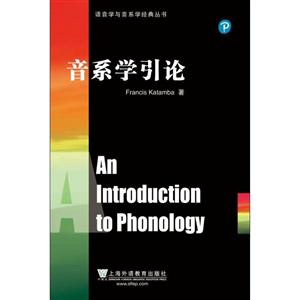Preface
Acknowledgements
Chapter 1 Introduction to phonetics
1.1 Introduction
1.2 The Production of speech
1.2.1 The production of consonants
1.3 The production of vowels
Chapter 2 The phoneme
2.1 Segments of sound
2.1.1 Distinctiveness: phonemes and allophones
2.2 Identifying phonemes
2.2.1 The minimal pair test
2.2.2 Contrast in analogous environments
2.2.3 Suspicious pairs
2.2.4 Recapitulation
2.3 Phonological symmetry
Chapter 3 Distinctive features
3.1 Why are features needed?
3.2 Jakobsonian features
3.3 The SPE system of distinctive features
3.3.1 Major class features
3.3.2 Cavity features
3.3.3 Tongue body features
3.3.4 Tongue root features
3.3.5 Laryngeal features
3.3.6 Manner features
3.3.7 Prosodic features
3.4 Segment structure redundancy
Chapter 4 Phonological representations
4.1 Phonetics and Phonology
4.2 The domain of phonology 66
4.3 Recapitulation: levels of representation
4.4 Phonetic and phonemic transcription
4.5 A guide to phonetic transcription
4.6 Why study Phonology?
Chapter 5 Phonological Processes 79
5.1 Introduction
5.2 Assimilation
5.2.1 Direction of assimilation
5.3 Assimilation Processes
5.3.1 Palatalisation
5.3.2 Labialisation
5.3.3 Voice assimilation
5.3.4 Place of articulation assimilation
5.3.5 Manner of articulation assimilation
5.3.6 Nasalisation
5.4 Dissimilation
5.5 Conclusion
Chapter 6 Naturalness and strength
6.1 Introduction
6.2 Natural segments, natural classes and natural processes
6.2.1 Phonological strength hierarchies
6.3 Explanations of naturalness
6.3.1 Natural phonology
Chapter 7 Interaction between rules
7.1 Introduction to rule formalisation and ordering
7.2 Linear rule ordering
7.3 Abandoning extrinsic ordering
7.4 Conclusion: why ordering matters
Chapter 8 The abstractness of underlying representations
8.1 Abstractness
8.2 Concrete phonology?
8.3 Absolute neutralisation
8.4 Conclusion
Chapter 9 The syllable
9.1 The syllable Is3
9.2 The representation of syllable structure
9.3 The CV-tier
9.3.1 A generative CV-phono logy model of syllable structure
9.3.2 Syllabification
9.4 Functions of the syllable
9.4.1 The syllable as the basic phonotactic unit
9.4.2 The syllable as the domain of Phonological rules
9.4.3 The syllable and the structure of complex segments
9.4.4 Compensatory lengthening
9.4.5 The syllable as indispensable building block for higher phonological domains
9.5 Syllable weight
9.6 Abstract segments
9.7 Extrasyllabicity
9.8 Summary
Chapter 10 Multi-tiered phonology
10.1 Introduction to tone languages
10.2 The nature of phonological representations
10.3 The representation of tone
10.3.1 Contour tones
10.3.2 Tone stability
10.3.3 Melody levels
10.4 The autosegmental model and the representation of tone
10.5 Tone and Intonation
10.6 Pitch-accent
10.7 Vowel harmony
10.8 Nasalisation
10.9 Morphemic tier
Chapter 11 Stress and intonation
11.1 Introduction: stress
11.1.1 What is stress?
11.1.2 Metrical phonology
11.1.3 Metrical trees and grids
11.1.4 Extrametricalty
11.1.5 Quantity sensitivity
11.1.6 English stress
11.2 Intonation
11.2.1 The form of English intonation
11.2.2 Accentuation function
11.2.3 Intonation and illocutionary force
11.2.4 The grammatical function of intonation
11.2.5 Attitudinal functions
11.2.6 Discourse function
Chapter 12 Phonology in the wider context
12.1 The role of the lexicon
12.2 Lexical phonology
12.21 Level I of lexical phonology
12.2.2 Level 2 of lexical phonology
12.2.3 The elsewhere condition
12.2.4 The order of affixes
12.2.5 Post-lexical rules
12.2.6 Summary
12.3 Prosodic domains
12.3.1 Prosodic domains and French Maison
12.4 Conclusion
Bibliography
Suggested answers to exercises
Language index
Subject index



















